Provoking and sustaining separatism and terrorism is good business. Money flows from across the border, and separatist leaders enrich themselves
Till the National Investigation Agency (NIA) caught up with him in Delhi on August 17, 70-year-old Zahoor Ahmad Shah Watali, a businessman, was indeed one of the most powerful persons in Kashmir valley. He was known to wield enormous clout in the corridors of power, both in Srinagar and Delhi. His influence continued despite change in regime in the state and at the centre. But in the summer of 2017, the NIA zeroed in on him as a suspected key conduit for funds given to all troublemakers in Kashmir – pro-Pakistani leaders, terrorists and stone-throwers. The investigations continue. But even before NIA sleuths swooped down upon Watali, raided 17 of his and his relatives’ properties in Jammu, Srinagar, Delhi and Gurugram, he was well-recognised as a mover and shaker in the shady world of separatists and the Inter-Services Intelligence (ISI) of Pakistan. Even in Delhi, surprisingly, bureaucrats, especially in the intelligence circles, would hear him out.
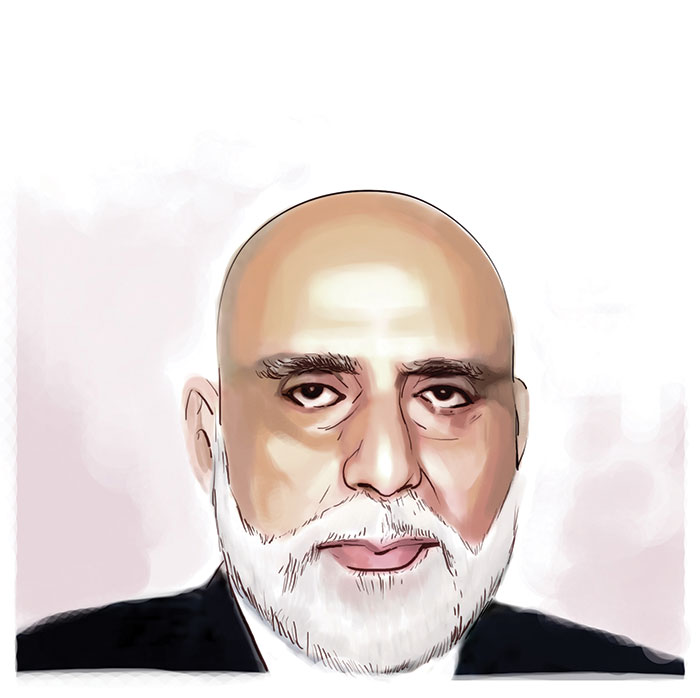
Zahoor Watali, at the centre of NIA investigations of terror funding
Looking back, Watali’s claim that the BJP government had sought his help to make Pakistan prime minister Nawaz Sharif agree to attend Narendra Modi’s swearing-in at Delhi in May 2014 does not seem like mere bluster. “He did help bridge the communication gap at that time. There were a lot of misgivings in Pakistan about Modi, and therefore, informal confirmation from Sharif was a must before we could send them a formal invite,” says a source well-versed with the matter. In Kashmir, separatists looked at him with awe, particularly after former ‘prime minister’ of PoK Sultan Mehmood Chaudhary came to Kashmir to attend the wedding of Watali’s son Yasir in September 2011. The Omar Abdullah government took this as an opportunity to generate goodwill among the Pakistanis, rolled out a red carpet for him and provided him with a chopper to have a bird’s eye view of the Valley. Chaudhary was overwhelmed and publicly thanked Watali for fulfilling his wish. Ironically, he was being hosted in the same Kashmir that his government was trying to wrest by sending terrorists and jihadis.
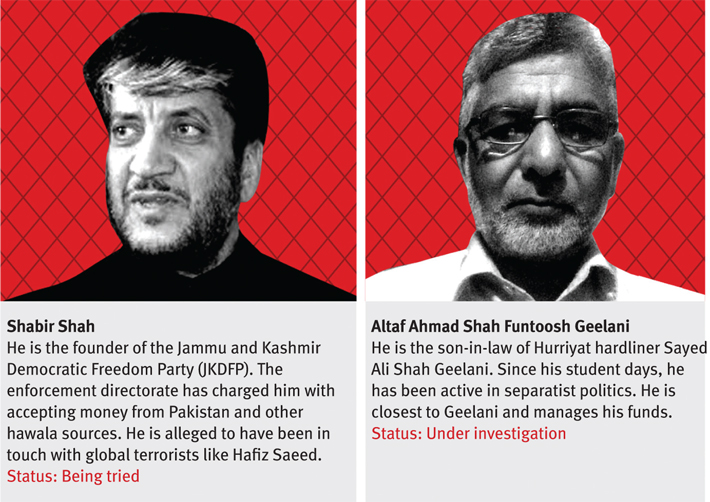
This single incident had raised Zahoor Watali’s graph by many notches; from being an obscure money operator in the jihad-terrorism game, he was now seen as someone with reach and influence in the corridors of power in Islamabad and Delhi.
Six years on, Watali is cooling his heels in a Delhi guesthouse that doubles as a lockup of the NIA. He is unable to explain to his interrogators, who are confronting him with facts about his money transactions and property documents, how he managed to acquire properties – flats, swathes of land in Jammu and Kashmir, houses in multiple locations in Kashmir, Dubai, Gurugram and London – from his known businesses. Many of these properties are benami. The NIA is scrutinising a long list of seized documents related to properties, financial transactions, bank passbooks. It’s also going through handwritten notes suspected to document money paid to Hurriyat leaders and also a number of laptops and electronic gadgets that will hopefully yield secret money trails. In the weeks to come, he could be charged with funding terrorism in Kashmir and possession of assets not matching his source of income.
Watali’s rise from a smalltime plywood merchant to one of the richest persons in Kashmir runs parallel to 28 years of jihadi terrorism, insurgency and unrest. It began around the time Pakistan trained the first batch of Jammu & Kashmir Liberation Front (JKLF) men in the use of weapons and in sabotage. Soon, thousands of Kashmiri youth began to be recruited for terror and taken across the border for training, to be sent back for carrying out attacks. Tonnes of money went into bankrolling this process. While bloodshed and mayhem was spread, the lifestyles of separatist leaders were seen changing. Many of them went on a property buying spree. Their rags-to-riches stories are a primer on the economics of jihad.
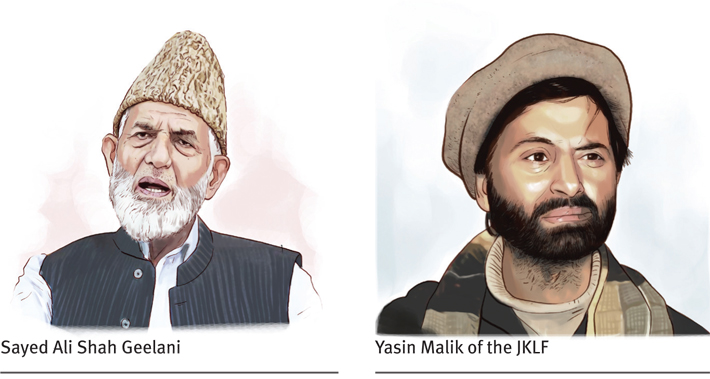
Watali rising
Among those stories, Watali’s is the most dramatic: he started out from Handwara, a small town in north Kashmir, ensconced in pine and deodar forests. His father Ghulam Nabi Watali had shifted from Srinagar in search of a better livelihood six decades ago. Watali senior had ventured into a small business. He sent one son, Ali Mohammad, to attend the local government school, and later the boy joined the police and rose to the rank of deputy inspector general. The younger lad was Zahoor, didn’t go to school. Townsfolk in Handwara remember Zahoor as a business-minded, adventurous and ambitious young man, who once drove taxi for a living.
At some later point, he had started a small timber trade. Timber, like insurgency, is a shady business in Kashmir; it thrives on the symbiotic relationship between corrupt officials of the police and forests with the unscrupulous merchants. The traders cut more trees than they are permitted to and transport them to towns and cities for sale without being questioned at the forest checkposts. Watali’s timber business was also not so clean, allege many of his acquaintances from Handwara.
Besides looking after his business, Watali was a regular hanger-on in the ‘durbar’ of the local politician, Abdul Ghani Lone. He would even help him financially. Though Watali wasn’t a member of Lone’s political outfit – the People’s Conference – he was quite close to him. At the onset of insurgency in Kashmir in the early 1990s, when politicians were fleeing the scene to escape bullets of the Pakistan-trained terrorists, a set of oligarchs – leaders of ragtag groups and smaller parties along with terrorists – turned de facto rulers of Kashmir. The Hurriyat thus came into being on the diktat of Pakistan; it comprised some 50 groups and political organisations like the People’s Conference and acted as the political facade of terrorists. Being one of the brightest politicians from the Valley, Lone was a key person in Pakistan’s scheme of things. However, his hubris didn’t make him an ideal partner for the ISI mandarins. Lone’s dilemma was that he was in league with the pro-Pakistanis but some of them were plotting against him. Lone was scared and felt insecure and it’s then Zahoor Watali, a tall man with a robust physique and an alert mind, was assigned a new role in his office. “He was like Lone’s shadow and everyone had to pass through him before meeting Lone Sahib,” a source said.
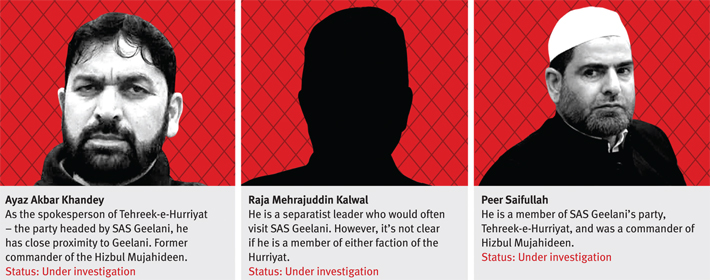
Today, Lone’s children are in different camps of the fragmented Kashmiri society: Sajjad Lone is a minister in the PDP-BJP cabinet, Bilal Lone is a member of the Hurriyat and daughter Shabnam Lone, a regular in acerbic primetime television debates, is a supreme court advocate. They speak dismissively of Watali as one of the hundreds of their father’s hangers-on. “Those days there were hundreds of such people and everyone found their own way up (to connect with the financer ISI); nobody needed to tell anyone how to curry favour with the ISI,” Shabnam Lone told Governance Now when asked about Watali’s link with their father. However, sources close to the family say Watali had distanced himself from the family of his mentor after the latter was killed in May 2002. Lone had finished speaking at a pro-freedom rally in Srinagar, when a gunman pumped bullets in his body, killing him on the spot in front of other leaders. The killer escaped by mingling in the crowd.
After speaking to various people who have known him, one can safely say that Lone had introduced his protege to the ISI. However, being a deft businessman, Watali took the terror-jihad sponsored by Pakistan as a business opportunity and made the most of it.
ISI’s favourite teller
Governance Now spoke to a senior Hurriyat leader to understand how Watali had emerged as a crucial link between the financers of Kashmir’s insurgency-cum-jihad and those who were getting richer on this. He spoke on the sole condition that his name and antecedents would not be disclosed. The front-rung leader of the All-Parties Hurriyat Conference (APHC) admitted that he had received a monthly allowance from Pakistan for five years. “I was getting about Rs 8-10 lakh per month. The money would come from the ISI and was delivered to me in cash by Zahoor,” he said. Watali, he alleged, deducted his 20 percent commission and handed over the rest to him with utmost punctuality. “I have no idea if he was supposed to take the 20 percent or not,” he said. This continued for five years until one day he was called by the ISI to Rawalpindi, the headquarters of the Pakistan army. He claims as soon as he arrived for the meeting, he could sense the tension around. “I asked them why we, the political leaders, were being contacted through a middleman.” He refused to disclose details of his interaction for obvious reasons but said the meeting ended on an unpleasant note. “They treat us like their servants.” After the meeting, he realised that his privy purse had been stopped by the ISI.
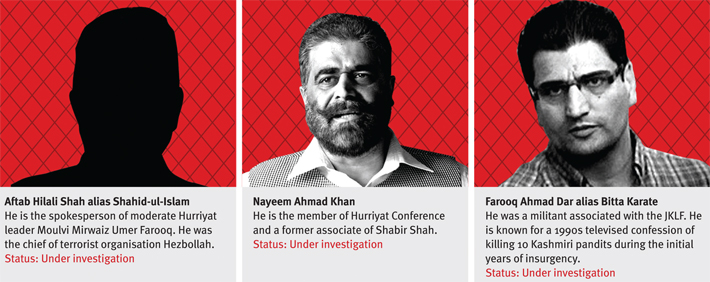
“The ISI, on one hand, kept in touch with leaders like me and on the other hand with middlemen like Zahoor [Watali], who would be asked to keep an eye on us,” he said. However, the Hurriyar leader claimed he never regretted losing the privy purse from the ISI. “Honestly, it is blood money. We were being paid so that we give good education to our children and get ordinary Kashmiris killed,” he said candidly.
Back then, he claimed, ISI was paying money to some 30 separatists in the Valley. Watali, he alleged, was a conduit for all and he received a handsome commission month after month. “When it started, ISI was very liberal in spending money, but gradually they are tightening spending; I can sense that back then it was bullish, and now it’s a bearish phase in the Kashmir financing department of the ISI,” he said.
However, the money trail from Pakistan has not dried up completely; a few months ago, funds were delivered to provide relief to the pellet injury victims of last summer’s violence following the killing of Burhan Wani. “To the best of my knowledge, the money has so far not been distributed by the Hurriyat,” he disclosed.
Money, money, money
Tracking cash flow is not easy, though the NIA has widened the investigation to include hawala operators and Kashmir-based traders who do business across the LoC with PoK through twin road routes in the state. However, the basic evidence of money reaching leaders is the huge assets they have acquired during the years of militancy. The sleuths would have to establish that the recipients of Pakistani and other overseas funds coming for terrorism in Kashmir had acquired properties disproportionate to their incomes. It’s an open secret that like Watali, many Hurriyat leaders had become rich overnight and some even flaunted their new found wealth by building palatial houses and buying real estate. The NIA claims it has recovered incriminating evidence to establish the money trail from abroad to the Hurriyat leaders via Watali for filing a chargesheet against them. Most of these leaders and their front men have a common link: they all have visited Dubai more frequently than they can justify and have made calls to common links there. Most of the hawala operation for funding Kashmir’s jihad, the NIA believes, is handled by Dubai-based hawala channels.
For the NIA, Hurriyat leaders are usual suspects but sources familiar with investigations on terror funds say the ISI’s money had reached at least two present-day legislators – one of whom, Engineer Rashid, an independent MLA from Lolab, has already been questioned by the NIA. Rashid, one of the most vociferous men in the assembly, could face more questioning, sources say. Some of the MLAs were allegedly paid for raising questions in the assembly to embarrass the government.
Though the NIA is tight-lipped about the interrogation of Hurriyat biggies like Shabir Ahmad Shah, Nayeem Khan and Altaf Ahmed Shah Fantoosh, sources say that it is proving to be a challenging task to establish money trails from Pakistan to Kashmir. The agency was mapping the disproportionate growth in the assets of these leaders during the years of militancy. At least two senior Hurriyat leaders are believed to have been identified as recipients of huge cash from Pakistan and their assets are being looked into. One of the Hurriyat leaders who continues to live in the traditional mud house built by his state transport corporation driver father in Srinagar downtown is alleged to have enormous benami properties in Srinagar. “It’s said he owns half of the Lal Chowk [the fashionable business centre of Srinagar] – all in the names of his confidantes, uncles, nephews and siblings,” a source said. The same leader has apparently built a palatial house in Islamabad, the costliest city in Pakistan, where his Pakistani wife and daughter live. “I have visited the house; it’s a mansion,” claimed a source in the Hurriyat. He also believed he must have channelised jihad funds into businesses in Pakistan in the name of his wife. He is yet to be formally arrested by NIA.
Shabir Ahmed Shah, who was once called the Nelson Mandela of Kashmir, is being probed both by the NIA and the Enforcement Directorate of the ministry of finance. His property and investments in businesses allegedly fetch him about Rs 4 lakh on a daily basis. His property – houses, lands, orchards – are in the names of his doctor wife, his sister-in-law and brother. He owns hotels in resorts like Pahalgam and large plots of commercial land.
The pro-Pakistan Hurriyat leader Sayeed Ali Shah Geelani’s son-in-law Altaf Ahmad Shah Funtoosh, who is in the NIA’s custody, is believed to be a key handler of funds. Though the 79-year-old Geelani has claimed he was never paid money, his assets have grown manifold in this period. For example, the two-storey house at Rehmatabad on the outskirts of Srinagar, where he has been under house arrest for six years to check his campaign of inciting Kashmiri youth to Islamist terror, is registered in the name of the “milli trust”. The trust has six members, four of whom are from Geelani’s family. He has allegedly amassed wealth and distributed the properties acquired through it among his children from two marriages. His youngest one, the Delhi-based daughter, who is married to a well-known journalist, is the only one in whose name there is no property registered. Nayeem Khan, who was once close to Shabir Shah has also built many houses and set up businesses during the period of insurgency.
Big crackdown
Beside Geelani, while most Hurriyat leaders are believed to have been recipients of funds from ISI, the NIA suspects a few of them have made a big killing. Going by the properties they have acquired during the last 28 years of unrest and turmoil, some Hurriyat leaders have enriched themselves immensely. Because tracking money trails is difficult, the NIA is analyzing their financial transactions and the cost of properties and asking them to explain the source of money. They are equally smart. Most of them have acquired their properties from the ill-gotten wealth in the name of their relatives, like uncles, cousins, siblings and spouses.
Though another key Hurrityat leader, Mirwaiz Moulvi Umer Farooq, has been quite well off, since his family is the main shareholder in Kashmir’s Jamia Masjid, his close aide Shahid-ul-Islam is being interrogated for details about the money his leader had been receiving. A former policeman, who was posted to guard the Mirwaiz, was found involved in transporting cash for him and is being questioned.
However, it’s not clear as to why the authorities didn’t act against alleged operators like Watali all these years. According to an IPS officer formerly posted in J&K, “Watali’s proximity to the Lone family was a reason that had restrained us from taking action against him.” Watali was once arrested along with the Lone brothers and JKLF chief Yasin Malik from his house in Srinagar. Watali spent eight months in prison but was never charged for a crime. The next time, he was booked when he tried to forcibly occupy a piece of land on Srinagar outskirts and had assaulted the lawful owner. He had a close shave with the law a third time when he knowingly used a cancelled passport to travel last year.
Besides probing the trails of ‘blood money’ from Pakistan and cutting the supply lines, the NIA has also swooped down on the gangs of stone pelters who had brought Kashmir to a grinding halt after Hizbul Mujahideen terrorist Burhan Wani’s death last year. An independent photojournalist arrested from south Kashmir had provided the NIA strong clues about the modus operandi of the stone pelters, their financers and also the social media groups that were being used to organise mobs for sabotage and obstructing the counterinsurgency operations by the army and security forces.
As part of its crackdown on Pakistan’s social media initiative for subversive activities, the ministry of electronics and information technology has got 115 Twitter handles blocked. These Twitter handles were extensively used to spread rumours and organise stone throwers over the last one year. Will this crackdown on the Hurriyat and its appendages help ending turmoil in Kashmir? It’s anybody’s guess.
aasha@governancenow.com
(The article appears in the October 31, 2017 issue)

